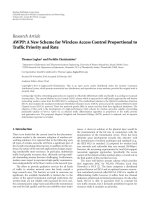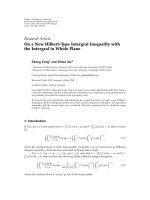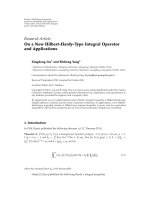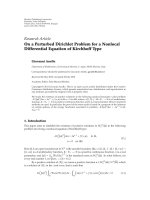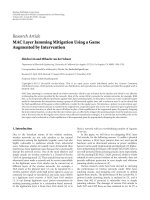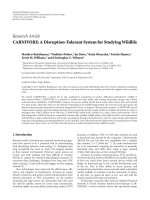Báo cáo hóa học: " Research Article Reverse-Engineering a Watermark Detector Using an Oracle" docx
Bạn đang xem bản rút gọn của tài liệu. Xem và tải ngay bản đầy đủ của tài liệu tại đây (2.17 MB, 7 trang )
Hindawi Publishing Corporation
EURASIP Journal on Information Security
Volume 2007, Article ID 43034, 7 pages
doi:10.1155/2007/43034
Research Article
Reverse-Engineering a Watermark Detector Using an Oracle
Scott Craver, Idris Atakli, and Jun Yu
Department of Electrical and Computer Engineering, Binghamton University, Binghamton, NY 13902, USA
Correspondence should be addressed to Jun Yu,
Received 7 May 2007; Accepted 22 October 2007
Recommended by A. Piva
The Break Our Watermarking System (BOWS) contest gave researchers three months to defeat an unknown watermark, given three
marked images and online access to a watermark detector. The authors participated in the first phase of the contest, defeating the
mark while retaining the highest average quality among attacked images. The techniques developed in this contest led to general
methods for reverse-engineering a watermark algorithm via experimental images fed to its detector. The techniques exploit the
tendency of watermark algorithms to admit characteristic false positives, which can be used to identify an algorithm or estimate
certain parameters.
Copyright © 2007 Scott Craver et al. This is an open access article distributed under the Creative Commons Attribution License,
which permits unrestricted use, distribution, and reproduction in any medium, provided the original work is properly cited.
1. INTRODUCTION
The Break Our Watermarking System (BOWS) contest gave
researchers a unique opportunity to test existing techniques
for breaking a watermarking algorithm [1]. The contest also
posed the researcher with a separate problem: given an un-
known watermark detector, can one deduce the underlying
algorithm from its output? This can also be attacked using
adaptive inputs to a detector, except in this case the inputs are
not used to find a better image, but to leak information about
a detector structure’s components. We used this approach to
reverse-engineer the BOWS watermark, by posing carefully
designed images to the watermark detector. Afterwards we
extended our techniques to a general algorithm for plumb-
ing a detection region with the goal of determining unknown
algorithm parameters.
This paper is organized as follows: in Section 2,wesum-
marize our participation in the BOWS contest, and the tac-
tics we used to reverse-engineer the underlying watermark-
ing algorithm. In Section 3, we extend our strategy to a
general mathematical approach to deducing an unknown
algorithm using oracle attacks. In Section 4, we show re-
sults for reverse-engineering a normalized correlation detec-
tor. We conclude that reverse-engineering a watermark de-
tector is possible, although an intelligent human being can
presently deduce far more with far fewer experimental in-
puts.
2. THE BOWS CONTEST
The Break Our Watermarking System (BOWS) contest chal-
lenged researchers to render an undetectable image water-
mark of unknown design. The goal was to attack water-
marked images while maintaining a minimum quality level
of 30 dB PSNR; the winner was the participant who main-
tained the highest average PSNR over three test images. In
the first phase of the contest, the algorithm was secret; for
the second phase, the algorithm was published.
Our research team applied the strategy of reverse-
engineering the watermark before attacking the images. We
determined the frequency transform, subband, and then an
exploitable quirk in the detector that made it sensitive to
noise spikes. This allowed us to achieve the highest average
PSNR, 39.22 dB PSNR, by the end of the first phase of the
contest [2]. The second phase was won by Andreas Westfeld,
who achieved an amazing quality level of 58.07 dB PSNR.
This quality level exceeded even the quantization error in-
curred by digitizing the image in the first place [3].
2.1. Reverse-engineering the detector
Our first step to defeating the watermark was determining
the watermark “feature space,” the image features which were
modified in order to embed the watermark. Watermarks are
often embedded in well-known transform domains as well as
2 EURASIP Journal on Information Security
(a) Image 1 (b) Image 2 (c) Image 3
Figure 1: The three images from the BOWS contest.
Figure 2: A severely degraded image (3.956 dB PSNR) with the
watermark still detectable, suggesting a feature space of 8-by-8 AC
DCT coefficients.
in the spatial domain; we suspected a common domain and
constructed experimental images to test our suspicions.
A critical aspect of our attack was to construct severe false
positives, images which should fail to trigger the detector un-
less a specific watermark feature space was being used.
1
We
call this property super-robustness: the property of a water-
marking algorithm to survive select types of quality degrada-
tion far beyond what any reasonable person would expect. If
we can distort an image in a way to make it unrecognizable
and if the watermark is still detectable, then we have found
an attack to which it is super-robust. This is in fact a secu-
rity weakness, because an unusual immunity to one attack
(which we call a mode of super-robustness) can leak informa-
tion about the underlying algorithm.
By testing various severe alterations of the image, we de-
termined that the watermark followed an 8-by-8 block trans-
1
While a “false positive” typically denotes an unwatermarked image mis-
taken for a watermarked one, we also consider an image a “false positive”
if it is so thoroughly altered that we expect it should have no detectable
watermark.
form, surviving attacks like the one in Figure 2.Wesuspected
a block DCT transform, which we further confirmed by ex-
periment. We then submitted images with bands removed
from each block. We determined the largest bands we could
remove without hurting the watermark, to determine the
suspected DCT subband used by the detector.
We used the knowledge that watermarks commonly re-
side in low-frequency and middle-frequency bands, a tactic
described by Miller et al. [4]. We also guessed that a water-
mark algorithm would employ subbands following geomet-
ric patterns, like upper triangular or square subsets of the
DCT matrix. Thus we erased lower-triangular sections of the
matrix and the gnomonic sections. The union of these two
attack regions gave us the largest “pattern” we could remove
without damaging the watermark. Figure 3 shows the small-
est region of geometric significance, which matched that used
by the BOWS watermark [5].
2.2. Breaking the watermark
To break the watermark, we first damaged a large interval of
feature space coefficients until the watermark was removed.
Then, we iteratively fixed the damaged coefficients while the
watermark remained undetectable. Our algorithm was as fol-
lows.
(1) Let C
1
, , C
n
be all in-band DCT coefficients, sorted
by decreasing magnitude.
(2) Find the smallest k such that the watermark fails when
coefficients C
1
, , C
k
are multiplied by a distortion
value D.
(3) For m
= k − 1 ···1,
(a) restore coefficient C
m
to its original value;
(b) if the watermark becomes detectable, redestroy
coefficient C
m
.
Our initial distortion value was D
= 0, meaning that we
eliminated DCT coefficients. Later we found that we could
achieve a higher quality by amplifying target coefficients in-
stead of zeroing them out. Ta ble 1 shows the result for image
1, where scaling four coefficients destroyed the watermark.
Scott Craver et al. 3
Table 1: Successive attacks for image 1. By amplifying a small set of
AC coefficients, the detector fails.
(Coefficient numbers)
∗
amplification PSNR
(12,69,107,127,132,140,141)
∗
3.4 37.53 dB
(12,69,127,132,140,141)
∗
3.4 38.19 dB
(12,69,127,140,141)
∗
3.4 38.97 dB
(12,69,127,141)
∗
3.55 39.67 dB
Figure 3: Experimental removal of DCT subbands. Shaded regions
are the largest lower-triangular and gnomonic subbands removable
without detector failure.
It is curious that so few coefficients need be modified: our
previous analysis suggested a subband of 49152 coefficients
per image (512-by-512 grayscale images, 4096 8-by-8 blocks,
12 AC coefficients taken per block,) so we suspected that our
attack was exploiting some detector weakness.
3. REVERSE-ENGINEERING USING AN ORACLE
In the first BOWS contest, the sensitivity attack was widely
used and proved to be very successful [3, 6, 7]. In this pa-
per,weuseoracleattacksforadifferent purpose: rather than
removing the watermark, we seek to learn as much as possi-
ble about an unknown watermarking algorithm. We model
a watermark detector as a three-stage algorithm. Images are
first subjected to a transform, for example, a DCT or wavelet
transform, to produce features used by the watermark em-
bedder. Then, a particular subband is chosen for embedding
and detection. Finally, the selected features are fed into a spe-
cific detection algorithm, which we model as computing a
detection statistic which is compared to a threshold. Wa-
termark detectors need not follow this structure, but many
do. If common transforms and detector statistics are used,
this structure implies a geometrically simple detection region
that facilitates our attacks.
Our methods for reverse-engineering mirror the strat-
egy used in the BOWS contest: create severe false positives
to identify an algorithm by its modes of super-robustness.
However, we also attempt to use the false positives to esti-
mate parameters of the detection region.
3.1. Constructing a noise snake
Our generic method to create a useful false positive to a
detector is to grow a “noise snake” using incremental uni-
form noise vectors. The technique of noise snakes entails the
growth of multiple false positives along the surface of a de-
tection region, leaking information about the watermark [8].
For certain detectors, such as normalized correlation detec-
tors, vectors along the detection region boundary have a sig-
nificant component along the watermark vector. This is be-
cause the detection region for normalized correlation is con-
ical [9]. In this case, an expanding noise vector will move
outward in a direction with a significant component along
the watermark vector, and so a severe false alarm will leak
information about the watermark.
Our noise snakes are constructed via the following algo-
rithm.
(1) Start with test image I, treated here as a vector.
(2) Initialize our snake vector to J
← I.
(3) Do for k
= 1, 2, , K the following.
(a) Choose a vector uniformly over the n-dimen-
sional unit hypersphere
S
n
.
This can be accomplished by constructing an
n-dimensional Gaussian vector XN (0, σ
2
I)and
scaling the vector to unit length.
(b) Choose a scaling factor α, which for normalized
correlation is proportional to the length of J.
(c) If J +αX still triggers the watermark detector, J
←
J + αX.
(d) Else, discard X and leave J unchanged.
In high dimensions, a noise snake seems to converge
quickly to the detection region boundary, and grow outward.
Instead of snakes within the detection cone, we have snakes
on a cone, which provide useful information about the detec-
tion region.
3.2. Estimation of a detection threshold
To use noise snakes to estimate detector parameters, we first
need the following lemma.
Lemma 1. If W is chosen uniformly over the unit n-sphere
S
n
,
and v is an arbitrary vector, the probability Pr [W
·v>cos θ]
is
S
n−1
S
n
θ
0
sin
n−2
xdx,(1)
where S is the surface volume of
S.
Proof. Since W is uniform, the probability of any set of vec-
tors is proportional to its measure. Let us integrate over the
v axis: consider point t
∈ [−1, 1] representing the v com-
ponent of the hypersphere. For each t,wehaveashellof
radius r
=
√
1 − t
2
, contributing a total hypersurface mea-
sure of S
n−1
r
n−2
√
dt
2
+ dr
2
. For example, a sphere in three
4 EURASIP Journal on Information Security
(a) Image 1 (b) Image 2 (c) Image 3
Figure 4: The three images after the attack. Note the few, but obvious, block artifacts.
w
(a)
φ
θ
w
(b)
Figure 5: Two independently generated snakes have approximately perpendicular off-axis components.
dimensions is composed of circular shells, and each circular
shell has contribution 2πr
√
dt
2
+ dr
2
= S
2
r
1
√
dt
2
+ dr
2
.The
sphere portion with angle beneath θ is
Area
=
r=sinθ
r
=0
S
n−1
r
n−2
dt
2
+ dr
2
=
r=sinθ
r
=0
S
n−1
r
n−2
1+
dt
2
dr
2
dr
=
r=sinθ
r
=0
S
n−1
r
n−2
1+
r
2
t
2
dr
=
r=sinθ
r
=0
S
n−1
r
n−2
dr
t
(2)
since 2tdt+2rdr
= 0. Substituting r = sinx,wegetdr/t = dx
and
Area
= S
n−1
θ
0
sin
n−2
xdx,(3)
and we divide by the total surface area S
n
to get the probabil-
ity of hitting that region.
The area of a unit hypersphere S
n
is
S
n
=
⎧
⎪
⎪
⎪
⎪
⎪
⎨
⎪
⎪
⎪
⎪
⎪
⎩
2
(n+1)/2
π
(n−1)/2
(n − 2)!!
for n odd,
2π
n/2
(1/2)n − 1
!
for n even.
(4)
The opening fraction C
n
= S
n−1
/S
n−2
therefore has a
closed form [10]
C
n
=
⎧
⎪
⎪
⎪
⎪
⎨
⎪
⎪
⎪
⎪
⎩
1
2
(n
− 2)!!
(n − 3)!!
for n odd,
1
π
(n
− 2)!!
(n − 3)!!
for n even.
(5)
Corollary 1. Foranarbitraryvectorv,auniformlychosenW,
and a positive
, Pr [W·v<cos(π/2+)] = Pr [W·v>
cos(π/2
− )].
Proof. We have Pr [W
·v<cos(π/2+)] = Pr [W·(−v) >
cos(π/2
−)]. Because W is uniform, Pr [W·(−v) > cos(π/2
−)] = Pr [W·(u) > cos(π/2−)], where u is any vector.
This means that if θ falls outside an interval of π/2, then
the above probability drops exponentially with dimension n.
This is the “equatorial bulge” phenomenon in high dimen-
sions: as the dimension n increases, the angle between two
Scott Craver et al. 5
uniformly chosen direction vectors will be within of π/2
with high probability.
Corollary 2. Two independently generated noise snakes have
off-axiscomponentswhichareclosetoperpendicular:asn in-
creases, the angle between the off-axis components converges to
π/2 in probability.
Proof. The density function of the set of noise snakes is rota-
tionally symmetric about the watermark axis due to the fact
that each component, a uniform vector, has a rotationally
symmetric density, and if s is a valid noise snake, so is Ts,
where T is any rotation holding the cone axis constant.
Because of this, the probability Pr [S
∈ F] = Pr [TS ∈
TF]. If we subtract w and then normalize each snake, the
symmetric distribution implies that W
= (S − w)/S − w
uniformly distributed over the unit n −1sphere.
To show that the angle converges to π/2 in probability, we
observe that for noise snakes S and T,withoff-axis compo-
nents W
1
= (S − w)/S − w and W
2
= (T − w)/T − w,
and for an
> 0,
Pr [
|W
1
·W
2
| > cos(π/2 −)]
= 2
S
n−1
S
n
π/2−
0
sin
n−2
xdx
≤
(n − 2)!!
(n − 3)!!
π
2
sin
n−2
(π/2 − ).
(6)
For any
, there exists an N such that for n>N,(n −2)/(n −
3)sinπ/2 − < 1, and so this bound goes to 0. Hence the
probability of falling outside an
of π/2dropsto0,andso
cos
−1
(W
1
·W
2
)convergestoπ/2 in probability.
This observation gives us a simple method to estimate
the cone angle from two constructed noise snakes X and Y
of equal length. Using trigonometry, we have (
√
2rsinθ)
2
=
r
2
+ r
2
− 2rr cos φ,whereφ is the angle between the snakes
and r is the snake length (see Figure 5). Rearranging,
sin
2
θ = 1 −X·Y,(7)
then we can calculate the cone angle and detector threshold
by generating two snakes of sufficient length, and computing
their dot product.
3.3. Estimation of feature space dimension
Once we have an appropriate estimate for the cone angle,
we can apply another technique to estimate the feature space
size, a more useful piece of information. To achieve this, we
use the detection oracle again to deduce the error rate under
two different noise power levels.
If we have a watermark vector w which falls within the
detection cone, and add a uniform noise vector r, the proba-
bility of detection is
Pr [δ
= 1] =
S
n−1
S
n
ψ
0
sin
n−2
xdx,(8)
ψ
= θ +sin
−1
w
r
sinθ
,(9)
1 1325374961738597109
Experiment number
0
0.1
0.2
0.3
0.4
0.5
0.6
0.7
0.8
0.9
1
Threshold
Estimated detector threshold
Figure 6: Estimated threshold using two noise snakes. The thresh-
old value is τ
= 0.5.
Estimated dimension
1 7 13 19 25 31 37 43 49 55
Experiment
0
100
200
300
400
500
600
700
800
900
1000
Dimension
Figure 7: Estimated dimension using two noise snakes. The feature
dimension is n
= 500.
where θ is the cone angle, which we estimate using the tech-
nique described earlier. The second equation has one un-
known, the watermark length
w. The top equation has one
unknown, n; the hit rate P
Y
can be estimated by experiment.
If we then consider P
Y
for uniform noise vectors of length
A, and then for noise of length B, we can combine these equa-
tions into the following identity:
tan θ
=
Asinψ
A
− Bsinψ
B
A cos ψ
A
− B cos ψ
B
, (10)
where ψ
A
and ψ
B
are the integration limits in (8). Here is our
algorithm.
(1) Choose power levels A and B. They can be arbitrary,
as long as the error rate under those noise levels is rea-
sonably estimable.
(2) Use the watermark detector to estimate P
A
and P
B
, the
detection rate under unform noise of lengths A and B,
respectively.
(3) For all suspected values of n, do the following.
6 EURASIP Journal on Information Security
0 0.1 0.2 0.3 0.4 0.5 0.6
Length r
0
0.05
0.1
0.15
0.2
0.25
0.3
0.35
0.4
0.45
0.5
Probability P
Y
P
Y
∗
r
∗
12
P
Y
(a)
0 0.1 0.2 0.3 0.4 0.5 0.6
Length r
0
0.05
0.1
0.15
0.2
0.25
0.3
0.35
0.4
0.45
0.5
Probability P
Y
P
Y
∗
r
∗
12
P
Y
(b)
Figure 8: Detection rate P
Y
and average growth rate αP
Y
as a function of the step length α. Above, a cone angle of π/3andn = 1000. Below
π/3andn
= 9000. The optimal step length to maximize αP
Y
is about 0.16 and 0.06, respectively.
(a) Use the hypothesized n and estimated detection
rates in (8) to estimate ψ
A
and ψ
B
. These param-
eters are easily determined by Newton’s method
in one dimension, because P
A
and P
B
are inte-
gralswithrespecttoψ
A
and ψ
B
,respectively.
(b) Compute
n
←|tan θ − (Asinψ
A
− Bsinψ
B
)/
(A cos ψ
A
− B cos ψ
B
)|.
(4) Choose the value of n that minimizes the error .
4. RESULTS
4.1. Estimating detector parameters
We tested these techniques using a generic watermark detec-
tor with a feature space of variable size selected from 8
× 8
AC DCT coefficients. We used normalized correlation with a
detection threshold of 0.5.
2
We first generated noise snakes
to deduce the detector’s threshold. Figure 6 shows our es-
timates for a detector with τ
= 0.5. This required an av-
erage of 1016 detector queries per experiment, to generate
two snakes. Figure 7 shows the corresponding dimension es-
timates, once the threshold is deduced to be 0.5.
Note that in this detector the asymptotic false alarm
probability is approximately 2.39
× 10
−33
. This means that
we can roughly estimate a very low false alarm probability in
only thousands of trials.
2
A proper detector should have a much higher threshold, since for τ = 0.5,
the false alarm rate is unnecessarily low. However, in our experience wa-
termark detectors are often designed in an ad hoc manner, and a threshold
value exactly between 0.0 and 1.0 is not uncommon.
4.2. Optimal step length
When generating a noise snake by adding a uniform noise
vector, we must confront two conflicting factors: large noise
vectors are more likely to move us out of the detection region,
but small noise vectors contribute little length per iteration.
The ideal noise vector length is one which maximizes the ex-
pected increment
αX·Pr [δ = 1].
When choosing a noise increment for a noise snake,
the appropriate amplification factor α is proportional to the
length of the snake as it grows. This can be seen by a simple
geometric argument: the cone is congruent to scaled versions
of itself. Thus if there is an optimal length α to extend a snake
of length 1, then Mα is optimal to extend a snake of length
M. We need only estimate the appropriate α for a snake of
unit length. Unfortunately, the optimal growth rate depends
on both cone angle and dimension, both of which are un-
knowns to the reverse-engineering.
The growth rate of a noise snake is thus exponential in
the number of queries. However, the growth rate is slow:
Figure 8 shows some estimates for α which range from 0.16 to
0.06, with n in the thousands. For larger feature sets, growth
is small. We determine in our experiments that for realistic
feature sizes, a snake of useful length requires a number of
queries roughly proportional to the dimension n.
5. CONCLUSION
We have developed several techniques for the reverse-
engineering of a watermark detector by construction of se-
vere false alarms. This approach mirrors our strategy in the
BOWS contest, in which we constructed experimental images
by trial and error, rather than by generic algorithm.
Our experience in the BOWS contest shows us that
human-guided reverse-engineering is much faster, requiring
Scott Craver et al. 7
dozens of queries rather than hundreds or thousands. Par-
tially, this was due to human knowledge of common water-
marking methods and transforms. Future research will ex-
plore how this knowledge can be codified to guide a generic
algorithm.
On the other hand, there may be means to prevent this
type of reverse-engineering attack. Suppose we are water-
mark designers, and we decide that enough is enough, that
we have had it with these snakes on this cone, what are we
going to do about it? The obvious remedy is preventing se-
vere false alarms, but it is not clear how to guarantee this. Any
watermark algorithm which embeds data in a set of features
is prone to this attack, because the remainder of the image
can be obliterated whilst preserving the watermark. This al-
lows severe false positives which leak information about the
detector.
ACKNOWLEDGMENTS
This research is made possible by support from the Air
Force Office of Scientific Research, under Award FA9550-
95-1-0440. Example code for algorithms in Sections 3.2 and
3.3, for estimating detector threshold and dimension, and
for estimating optimal snake growth, can be found online at
/>∼scraver/snakeCode.tar.
REFERENCES
[1] “The Break Our Watermarking System (BOWS) contest,”
fi.it/BOWS/.
[2] S.Craver,I.Atakli,andJ.Yu,“HowwebroketheBOWSwater-
mark,” in Security, Steganography, and Watermarking of Multi-
media Contents IX, vol. 6505 of Proceedings of SPIE,SanJose,
Calif, USA, January 2007.
[3] Westfeld A., “Tackling bows with the sensitivity attack,” in Se-
curity, Steganography, and Watermarking of Multimedia Con-
tents IX, vol. 6505 of Proceedings of SPIE, San Jose, Calif, USA,
January 2007.
[4] M. L. Miller, G. J. Doerr, and I. J. Cox, “Applying informed
coding and embedding to design a robust, high capacity wa-
termark,” IEEE Transactions on Image Processing, vol. 13, no. 6,
pp. 792–807, 2004.
[5] I. J. Cox, J. Kilian, F. T. Leighton, and T. Shamoon, “Secure
spread spectrum watermarking for multimedia,” IEEE Trans-
actions on Image Processing, vol. 6, no. 12, pp. 1673–1687, 1997.
[6] A. Westfeld, “Lessons from the bows contest,” in Proceedings of
the Multimedia and Security Workshop, vol. 2006, pp. 208–213,
Geneva, Switzerland, 2006.
[7] P. Comesa
˜
na and F. P
´
erez-Gonz
´
alez, “Two different ap-
proaches for attacking bows,” in Security, Steganography, and
Watermarking of Multimedia Contents IX, vol. 6505 of Proceed-
ings of SPIE, San Jose, Calif, USA, January 2007.
[8] S. Craver and J. Yu, “Reverse-engineering a detector with false
alarms,” in Security, Steganography, and Watermarking of Mul-
timedia Contents IX, vol. 6505 of Proceedings of SPIE,SanJose,
Calif, USA, January 2007.
[9] M.L.Miller,I.J.Cox,andJ.A.Bloom,Digital Watermarking,
Morgan Kaufman, San Francisco, Calif, USA, 2002.
[10] “Hypersphere—from Wolfram MathWorld,” http://www
.mathworld.wolfram.com/Hypersphere.html.
